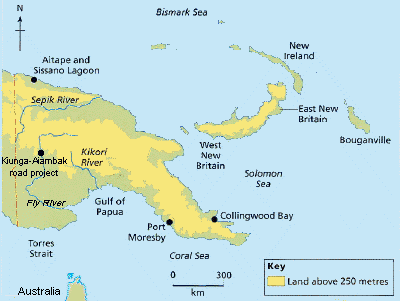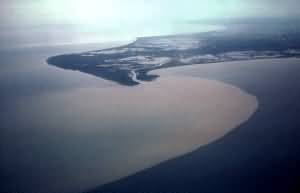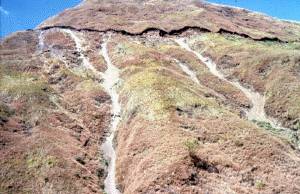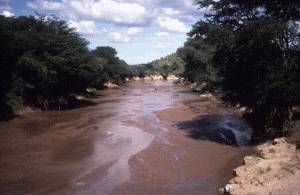Tropical Rainforest Case Study: Papua New Guinea
|
Vocabulary |
|
Conservation: to manage the environment in such a way that it will be protected from change. Exploitation: when the environment is used in such a way that it is destroyed and will be of no use to future generations. Sustainable development: the development of an area using techniques and approaches that will help to protect the environment for the future. |
| Source: 'Tomorrow's Geography', Harcourt and Warren, Ed. Warn, Hodder & Stoughton |
Location of the case study
 |
Rainforest Exploitation
Papua New Guinea (PNG) possesses one of the planet's largest remaining tropical rainforest. At least seventy-five percent of its original forest cover is still standing, occupying vast, biologically rich tracts over 100,000 square miles in all. Its forests provide the habitat for about 200 species of mammals, 20,000 species of plants, 1,500 species of trees and 750 species of birds, half of which are endemic to the island. It has been estimated that between 5 and 7% of the known species in the world live in PNG. Rare plants and animals like the largest orchid, the largest butterfly, the longest lizard, the largest pigeon and the smallest parrot ever registered live in these forests.
The forests also constitute the home of the indigenous peoples, the Maisin. For the Maisin, forests provide everything from food and medicinal plants, to materials for houses, canoes and tools. Under the Papua New Guinea constitution, the Maisin are the legal owners of their traditional lands. But these forests and forest peoples are under threat due to large-scale logging activities and oil palm plantations. Oil palm plantations are not aimed at the production of edible oil for the local population and almost the entire production is export-oriented.
| Resource Exploited | Problems Created | Groups For | Groups Against |
| Timber extraction e.g. Kiunga-Aiambak road project located in previously intact rainforests in Papua New Guineas remote Western Province. | Soil erosion
Loss of biodiversity Diseases spread amongst indigenous Maisin population through contact with the timber cutters Increase in viral diseases and malaria, because of the ecological changes deforestation causes Loss of game animals Loss of clean water supply through sedimentation |
PNG Government: who sold logging rights and helped
finance the project
Transnationals and their shareholders: Malaysian company bought logging rights Consumers in MEDCs who want cheap plywood and furniture Indigenous population who obtain work with the logging company
|
Landowners: not consulted and paid very little in
compensation for the loss of their cocoa smallholdings.
Environmental groups: e.g. Greenpeace Australian Government: Australia lies too close to Papua New Guinea to be isolated from its social problems Indigenous population who object to the logging companies illegally taking over their land and the cultural, social and financial problems that followed |
| Oil palm plantation at Aitape | Sedimentation and Eutrophication caused through
soil erosion (after forest clearance) and use of fertilisers would kill the
nearby coral reef in Sissano Lagoon
Prawn and sea fishing industry destroyed in Sissano Lagoon through use of fertilisers and pesticides |
PNG Government: offers tax incentives in the oil palm
sector designed to encourage growth and boost production
Transnational oil palm companies and their shareholders Plantation workers have jobs Fertiliser and pesticide company have more sales |
Indigenous people who claim legal rights to the land
seized from them
Local fishermen who would lose their livelihoods Tour companies and workers: the coral reef attracts tourists and divers Tourists who prefer to see unspoilt coral reefs |
 |
| Sissano Lagoon: coral reef and fishing industry threatened by sedimentation after forest clearance |
 |
| Ease of access resulting from the incursion of a logging road has resulted in the complete loss of forest cover and subsequent soil erosion |
 |
| The effects of forest clearance on water quality |
Sustainable Development and Forest Conservation
Funded by the Chevron Oil company and Greenpeace and agreed by the PNG government after being taken to court by the Maisin people. The PNG government has been under pressure from the World Bank and International Monetary Fund (IMF), and the Australian Government to enforce environmentally-friendly changes in their development programme. Awareness patrols to remote areas by local environmental charity groups have been spreading the message of what exploitative logging will do to rural communities. The recent screening on PNG television station EMTV of the Rainforest Information Centre's documentary Mama Bilong Olgeta on the PNG logging industry was a great success.
| "The
Papua New Guinea government has decided to exclude Maisin customary lands,
located in Collingwood Bay from plans for timber or large scale agricultural
development. Greenpeace and others have been active in the area in developing
small scale alternative community development schemes. Despite numerous
community attempts to have their land removed from large scale industrial
development consideration, a number of schemes were proposed. This action should
give the community the room they need to regulate their own development
potential in a sustainable, community owned manner."
PNG Government Press Conference statement following the Maisin court case |
Sustainable Development Techniques Employed
-
Community-based sustainable forestry
-
Training in sustainable forestry
-
Fish farming
-
Butterfly farming
-
Eco-tourism
-
Managed conserved areas
-
Cottage industries: nut harvesting, tourist souvenir and tapa cloth production
-
Greenpeace active in developing Maisin cloth and art markets in the USA
-
Local log-processing industries are being established. Processed timber is worth much more on the world market
-
Small logging operations are encouraged, owned by many different companies, who all have certified sustainable management certificates
Problems Encountered
- High levels of illiteracy and lack of skills create difficulties in dealing with tourists
- Rivalries between different tribal clans makes team work difficult
- Government difficulties in controlling the activities of the multinational logging companies
|
||||
More information for this case study can be found in 'Tomorrow's Geography', Harcourt and Warren, Ed. Warn, Hodder & Stoughton www.hodderheadline.co.uk
Further reading on the role of China in the destruction of the tropical forests of Southeast Asia including Papua New Guinea: Forests in Southeast Asia Fall to China
The Australian Orangutan Project is also maintaining updates to PNG Palm Oil Plantation Issues.
